When Ikoria was first announced, there was speculation that this would be the kaiju set—earth-shaking creatures with mythic powers. There’s not much “lair” to our lair of behemoths, but hundred-story monsters aren’t known for their subtlety. Suitably, Ikoria feels massive—creatures are bigger, stakes are higher, and the heroes and villains of the story are primal and archetypal.
Ikoria’s mechanics split into two camps—there’s the wildness of Companion and Mutate, and the simplicity of Cycling and ability keywords. I’m on record as wanting cycling in every single expansion set. It’s somewhat surprising to see Cycling (1) on situational cards, especially so soon after the imminently playable Censor, but that change should make Limited more fluid and interesting. [Editor’s note: But see Zenith Flare.]
Cycling has shown up in Urza’s block, Onslaught block, Time Spiral block, Shards block, Khans block, and Amonkhet block—all of these, save for possibly Amonkhet and arguably Onslaught blocks, are regarded as excellent formats. There’s no better feeling in Limited than being able to play almost every card you drafted, and Cycling helps facilitate that feeling—absolute worst case, you can play off-color cards to get to 23 just for the cycling. Or you can play so many cyclers that your “23” turns into 27 or 28.
Ability counters are fine—it’s a great way to add minor benefits to temporary stat boosts.
Mutate
I may be one of the last people who still shuffles up Hecatomb, Wizards’ ill-fated apocalyptic monster-building game from the mid-aughts. The cards were hexagonal and were made of transparent plastic, which you overlaid over other cards to create larger creatures with cumulative abilities. A combination of audience disinterest, petroleum costs, and design choices killed the game within a year.
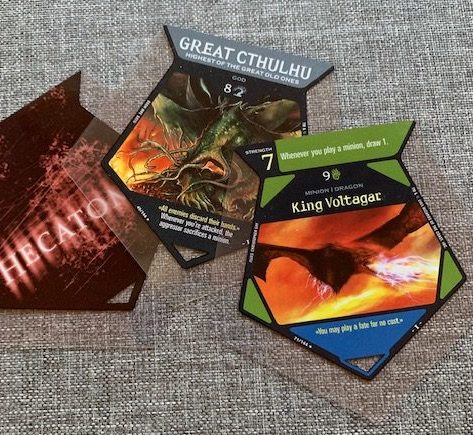
Hecatomb attempted to fix Magic’s mana system by making every card in your hand playable as a mana source, and Hecatomb cards had abilities pilfered from Magic with less evocative names, like Fanatic instead of Haste. It was as thought Wizards was trying to make its own knock-off, instead of patenting the Magic system and building other games around the core mechanics. (The “Deckmaster” brand has long since passed into history as well.) Hecatomb had a strong concept, though—who doesn’t want to build their own monster?
Mutate is a variant of the core Hecatomb innovation—overlaying creatures to create bigger abominations—without the fiddly cards, which were hard to determine the untapped status of and unwieldy to shuffle. Unlike Hecatomb, power and toughness aren’t cumulative, but you can stack up abilities until you have an Akroma. I hate that, unlike Hecatomb, killing one kills the entire Mutated creature; but most of the playable Mutate cards at least give you some form of soft card advantage when Mutated.
The ability will no doubt return eventually. I recommend picking up playable Mutate cards when they rotate out of Standard and cashing them out in a few years when a pushed Mutate-matters Commander gets spoiled. Until then, Mutate seems too parasitic to be memorable, although I look forward to putting Trample counters on Questing Beast and then mutating onto it.
The gravamen of Magic design, to put it cynically, is “will this sell more packs than it causes disruption to the current player base?” In any other year, I’d say Mutate breaks closer to the “disruption” side of that criterion. But in this year—when paper play will be limited and online will be the primary mode of play—there’s enough automatic regulation in the game’s engine that Mutate will play well. You can’t accidentally Mutate on a Human if you can’t highlight the Human, and the game itself will keep track automatically of how many times you’ve mutated.
Companion
Now here’s the disruption. Lurrus is already proving their power—not surprisingly, since older formats skew low to the ground in terms of mana cost already—and Gyruda has led to a pretty elegant Standard combo. The pure chaos of a mechanic that results in an immediate Commander ban, a Black Lotus/Lion’s Eye Diamond loop, a Standard graveyard combo, and an eight-card starting hand for every deck is laudable, but definitely dangerous.
This would be a boundary-pushing mechanic in a Commander deck series; in Standard, it’s avant garde. I think we’ll see at least two of the Companions catching a ban in June, with Lurrus as the obvious choice. Lurrus rewards you for playing low-to-the-ground, which tournament Magic has always done.
Godzilla
Personally, I like the Godzilla cards. I don’t have much of an attachment to the franchise, but the crossover is thematically appropriate. Maybe my priorities are changing as I get older, but the Secret Lair series and the various “booster fun” card frames have trained me to recognize what isn’t geared towards me, a casual and Limited player. Above all else, each new wacky frame gets me closer to my chromatic Commander deck where every single card has a different frame and art style, so I’m sanguine about them. I would have preferred it be saved for a Secret Lair rather than a Standard set, like the recently announced Godzilla lands Secret Lair, but they’re pretty easy to opt out of using.

If you were completely unfamiliar with Godzilla, these cards, for the most part, would still look like Magic cards. Dorat, the Perfect Pet looks silly, but no sillier than a Lorwyn Faerie or the (subjectively stellar) art on Humble. I don’t love the modern touches to some of these—e.g., the buildings on Mothra—but some of the more contextless pieces like Godzilla, Doom Inevitable could be printed on a Jund-flavored card with no changes.
If they go back to this well too often, though, and we end up equipping Cloud’s Buster Sword to Smaug in Mystery Booster 2028, we’ll lose the flavor that made Magic a culture-altering phenomenon. Modern fiction has always crept into Magic, since Alpha—but it’s been more Easter eggs than direct references, like Angus Mackenzie’s resemblance to certain pop culture enchanters.
Individual Cards
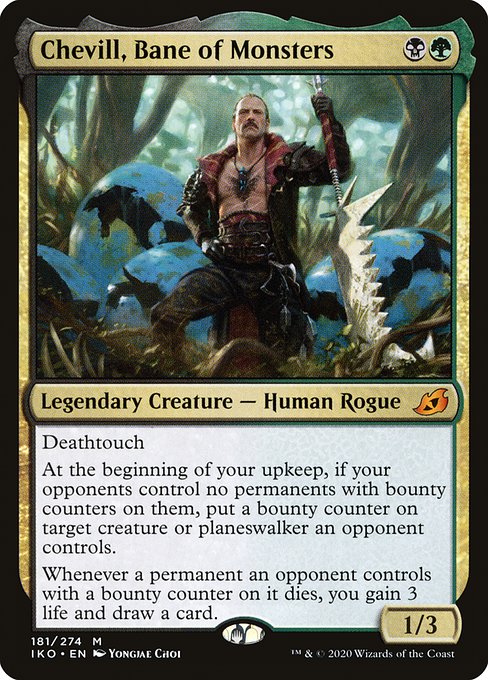
Huge fan of the fact that, thanks to Eldraine, every time I see “3 life” on a card, I’ll see it as Food. Crypt Incursion is now just eating an entire graveyard’s worth of carcasses. Obviously, the Food connection is intentional for Chevill, Bane of Monsters, and it’s great flavor.
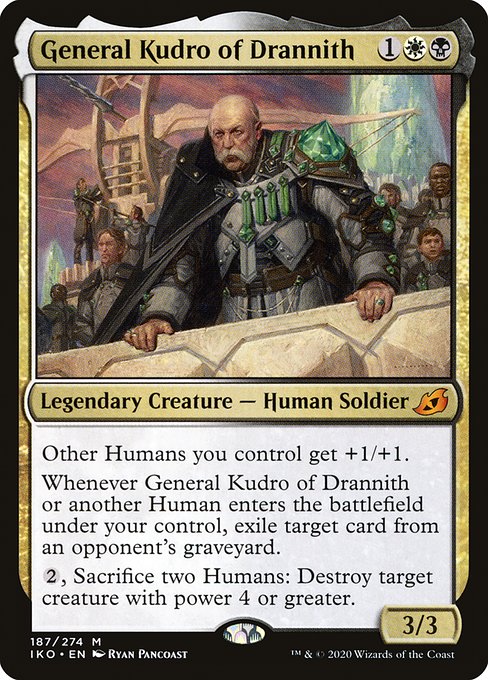
The human element of Ikoria, perhaps ironically, is far more interesting than the monster aspect of the set. There’s a dark undercurrent that approaches ecofascism, as demonstrated best in General Kudro of Drannith, who is willing to sacrifice his community to save some nebulous concept of “community” from an external threat. Dark stuff, but it’s a dark world—and a dark plane.

Overgrown Estate/Squandered Resources/Zuran Orb plus Field of the Dead plus Eerie Ultimatum is an absurd Commander strategy.

Ikoria loves to take playable cards and stick an upside onto them. This card would have been in development around the time of Faithless Looting’s dominance, so I wonder if we’ll see more “looting” cards that stick the card on the bottom, rather than discard. It makes sense for Red.
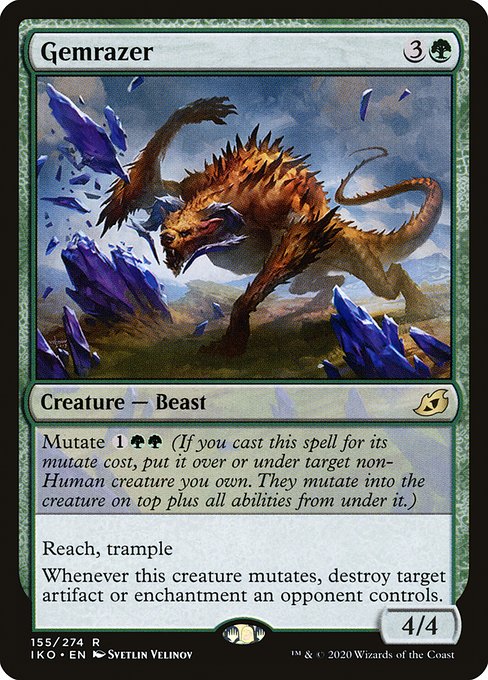
I’ve seen Gemrazer compared to Boon Satyr or Woodland Wanderer, both of which were low-impact. I think that’s inaccurate—this is designed exclusively to be slapped onto Glistener Elf or Ichorclaw Myr. Hateful. I love him.
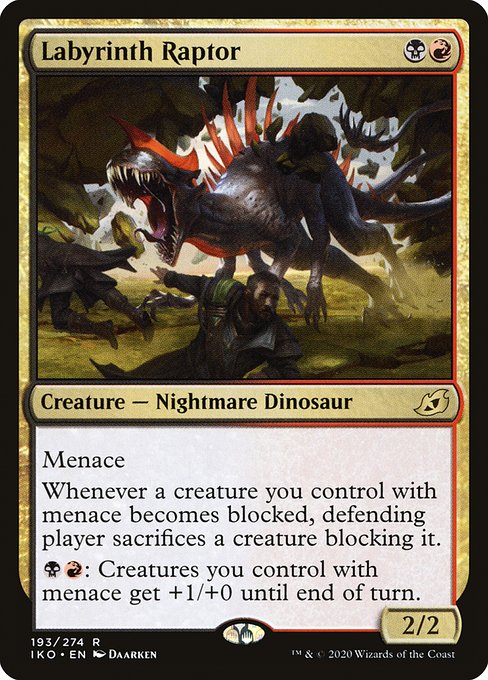
I love Menace because, like Vigilance or First Strike, Wizards seems to consider as worth about half a mana; eventually a Menace creature will be printed above the curve enough to matter. Unfortunately, I think Labyrinth Raptor is the equivalent of a punisher card that reads “Creatures you control with Menace are unblockable until your opponent needs them to be blocked.” More of a bad Desecration Demon than an archetype creator.
Still, I’d be remiss if I didn’t include a list of playable Menace cards in Standard/Pioneer: Stormfist Crusader, Atris, Oracle of Half-Truths, Dreamstealer, Glint-Sleeve Siphoner, Goblin Dark-Dwellers, Insolent Neonate, Massacre Girl, Noxious Gearhulk, Pestilent Spirit, Rampaging Ferocidon, and Relentless Dead. But not Soulflayer!

Sea-Dasher Octopus, more than any other card, has me excited about Mutate. No one version of this card is above the curve, but the flexibility it offers makes it play better than it looks. It’s not Ninja of the Deep Hours, because it builds your board rather than setting it back. It’s not Stealer of Secrets, because it can scale up. We haven’t seen precisely this card before, but we’ll be seeing it a lot in the future.
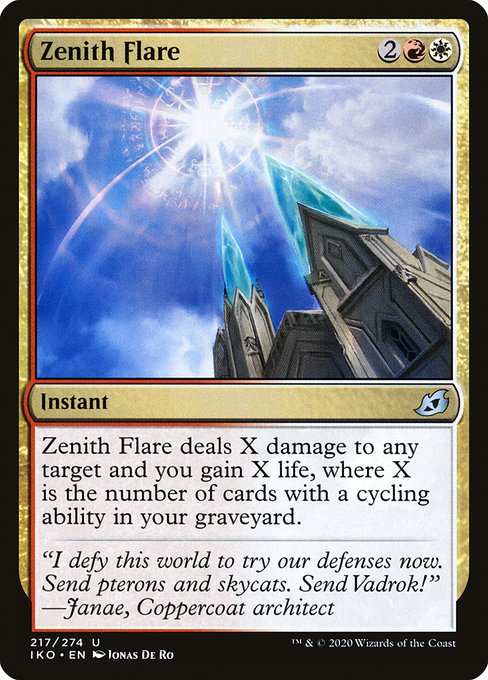
Ah yes, Zenith Flare. The fact that this is “any target” and not restricted to creature/Planeswalker makes me want to build Modern Mardu Mill with Creeping Chill, Street Wraith, and all the cycling cards possible. It could also offer some extra “reach” for Living End decks, maybe.
All in all, I’m excited for Ikoria. It’s swinging for the fences, and it’s going to hit a foul ball or two, but the love of the game comes through. Companion is proving to be a problem, and it’ll require careful format management, but it’s inspiring in its ferocity. Much like Oko’s format-spanning dominance mirrored the decadence of Eldraine, the violence of Companion mirrors the predation of Ikoria. That doesn’t mean it’s fun gameplay, but it’s appealing design; and that, I suspect, is what we’ll remember Ikoria for.
A lifelong resident of the Carolinas and a graduate of the University of North Carolina, Rob has played Magic since he picked a Darkling Stalker up off the soccer field at summer camp. He works for nonprofits as an educational strategies developer and, in his off-hours, enjoys writing fiction, playing games, and exploring new beers.

